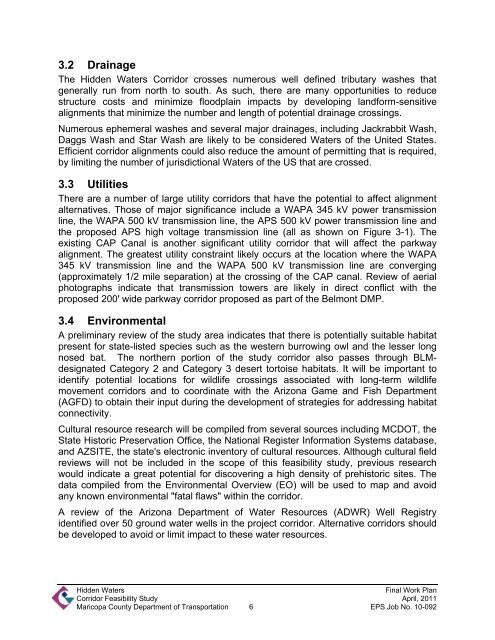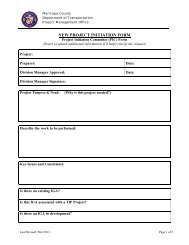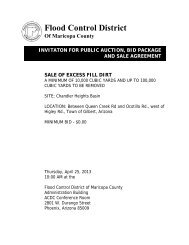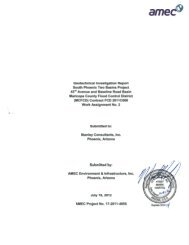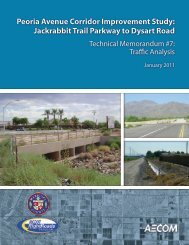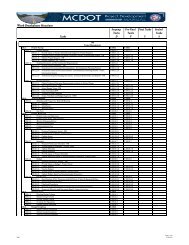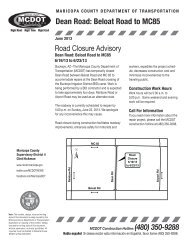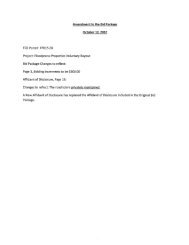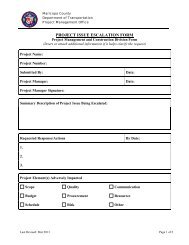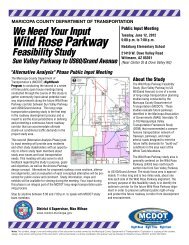Work Plan - Final - Maricopa County Department of Transportation
Work Plan - Final - Maricopa County Department of Transportation
Work Plan - Final - Maricopa County Department of Transportation
You also want an ePaper? Increase the reach of your titles
YUMPU automatically turns print PDFs into web optimized ePapers that Google loves.
3.2 DrainageThe Hidden Waters Corridor crosses numerous well defined tributary washes thatgenerally run from north to south. As such, there are many opportunities to reducestructure costs and minimize floodplain impacts by developing landform-sensitivealignments that minimize the number and length <strong>of</strong> potential drainage crossings.Numerous ephemeral washes and several major drainages, including Jackrabbit Wash,Daggs Wash and Star Wash are likely to be considered Waters <strong>of</strong> the United States.Efficient corridor alignments could also reduce the amount <strong>of</strong> permitting that is required,by limiting the number <strong>of</strong> jurisdictional Waters <strong>of</strong> the US that are crossed.3.3 UtilitiesThere are a number <strong>of</strong> large utility corridors that have the potential to affect alignmentalternatives. Those <strong>of</strong> major significance include a WAPA 345 kV power transmissionline, the WAPA 500 kV transmission line, the APS 500 kV power transmission line andthe proposed APS high voltage transmission line (all as shown on Figure 3-1). Theexisting CAP Canal is another significant utility corridor that will affect the parkwayalignment. The greatest utility constraint likely occurs at the location where the WAPA345 kV transmission line and the WAPA 500 kV transmission line are converging(approximately 1/2 mile separation) at the crossing <strong>of</strong> the CAP canal. Review <strong>of</strong> aerialphotographs indicate that transmission towers are likely in direct conflict with theproposed 200' wide parkway corridor proposed as part <strong>of</strong> the Belmont DMP.3.4 EnvironmentalA preliminary review <strong>of</strong> the study area indicates that there is potentially suitable habitatpresent for state-listed species such as the western burrowing owl and the lesser longnosed bat. The northern portion <strong>of</strong> the study corridor also passes through BLMdesignatedCategory 2 and Category 3 desert tortoise habitats. It will be important toidentify potential locations for wildlife crossings associated with long-term wildlifemovement corridors and to coordinate with the Arizona Game and Fish <strong>Department</strong>(AGFD) to obtain their input during the development <strong>of</strong> strategies for addressing habitatconnectivity.Cultural resource research will be compiled from several sources including MCDOT, theState Historic Preservation Office, the National Register Information Systems database,and AZSITE, the state's electronic inventory <strong>of</strong> cultural resources. Although cultural fieldreviews will not be included in the scope <strong>of</strong> this feasibility study, previous researchwould indicate a great potential for discovering a high density <strong>of</strong> prehistoric sites. Thedata compiled from the Environmental Overview (EO) will be used to map and avoidany known environmental "fatal flaws" within the corridor.A review <strong>of</strong> the Arizona <strong>Department</strong> <strong>of</strong> Water Resources (ADWR) Well Registryidentified over 50 ground water wells in the project corridor. Alternative corridors shouldbe developed to avoid or limit impact to these water resources.Hidden Waters<strong>Final</strong> <strong>Work</strong> <strong>Plan</strong>Corridor Feasibility Study April, 2011<strong>Maricopa</strong> <strong>County</strong> <strong>Department</strong> <strong>of</strong> <strong>Transportation</strong> 6 EPS Job No. 10-092


